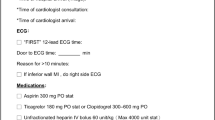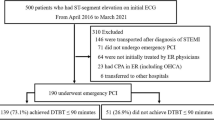Abstract
Patients with acute myocardial infarction (AMI) presenting with syncope have poor clinical outcomes partly due to a delay in the diagnosis. Although the impact of prehospital 12-lead electrocardiography (PHECG) on the reduction of first medical contact (FMC)-to-device time and subsequent adverse clinical events in patients with AMI has been demonstrated, the impact of PHECG for the patients presenting with syncope remains to be elucidated. This study aimed to explore the impact of PHECG on 30-day mortality in patients with ST-segment elevation myocardial infarction (STEMI) presenting with syncope. From a cohort of multi-center registry [Kanagawa-ACuTe cardIoVascular rEgistry (K-ACTIVE)], a total of 90 consecutive patients with STEMI presenting with syncope were included. The 30-day mortality were compared between patients with PHECG (PHECG group, n = 25) and those without PHECG (non-PHECG group, n = 65). There was no significant difference in the baseline clinical characteristics between the 2 groups. FMC-to-device time was significantly shorter in the PHECG group than in the non-PHECG group (122 [86, 128] vs. 131 [102, 153] min, p = 0.03) due to the shorter door-to-device time. Thirty-day mortality was significantly lower in the PHECG group than in the non-PHECG group (16.0 vs. 44.6%, p = 0.03). In conclusion, PHECG was associated with shorter FMC-to-device time and lower 30-day mortality in patients with STEMI presenting with syncope.




Similar content being viewed by others
References
Goldberg RJ, Mooradd M, Gurwitz JH, Rogers WJ, French WJ, Barron HV, Gore JM (1998) Impact of time to treatment with tissue plasminogen activator on morbidity and mortality following acute myocardial infarction (the second national registry of myocardial infarction). Am J Cardiol 82:259–264
Newby LK, Rutsch WR, Califf RM, Simoons ML, Aylward PE, Armstrong PW, Woodlief LH, Lee KL, Topol EJ, Van de Werf F (1996) Time from symptom onset to treatment and outcomes after thrombolytic therapy. J Am Coll Cardiol 27:1646–1655
Hannan EL, Zhong Y, Jacobs AK, Holmes DR, Walford G, Venditti FJ, Stamato NJ, Sharma S, King SB (2010) Effect of onset-to-door time and door-to-balloon time on mortality in patients undergoing percutaneous coronary interventions for ST-segment elevation myocardial infarction. Am J Cardiol 106:143–147
McNamara RL, Wang Y, Herrin J, Curtis JP, Bradley EH, Magid DJ, Peterson ED, Blaney M, Frederick PD, Krumholz HM (2006) Effect of door-to-balloon time on mortality in patients with ST-segment elevation myocardial infarction. J Am Coll Cardiol 47:2180–2186
Terkelsen CJ, Lassen JF, Nørgaard BL, Gerdes JC, Poulsen SH, Bendix K, Ankersen JP, Gøtzsche LB-H, Rømer FK, Nielsen TT, Andersen HR (2005) Reduction of treatment delay in patients with ST-elevation myocardial infarction: impact of pre-hospital diagnosis and direct referral to primary percutanous coronary intervention. Eur Heart J 26:770–777
Brown JP, Mahmud E, Dunford JV, Ben-Yehuda O (2008) Effect of prehospital 12-lead electrocardiogram on activation of the cardiac catheterization laboratory and door-to-balloon time in ST-segment elevation acute myocardial infarction. Am J Cardiol 101:158–161
Martinoni A, De SS, Boschetti E, Zanini R, Palmerini T, Politi A, Musumeci G, Belli G, De PM, Ettori F, Piccaluga E, Sangiorgi D, Repetto A, D’Urbano M, Castiglioni B, Fabbiocchi F, Onofri M, De CN, Sangiorgi G, Lettieri C, Poletti F, Pirelli S, Klugmann S (2011) Importance and limits of pre-hospital electrocardiogram in patients with ST elevation myocardial infarction undergoing percutaneous coronary angioplasty. Eur J Cardiovasc Prev Rehabil 18:526–532
Ong MEH, Wong ASL, Seet CM, Teo SG, Lim BL, Ong PJL, Lai SM, Ong SH, Lee FCY, Chan KP, Anantharaman V, Chua TSJ, Pek PP, Li H (2013) Nationwide improvement of door-to-balloon times in patients with acute ST-segment elevation myocardial infarction requiring primary percutaneous coronary intervention with out-of-hospital 12-lead ECG recording and transmission. Ann Emerg Med 61:339–347
Carstensen S, Nelson GCI, Hansen PS, Macken L, Irons S, Flynn M, Kovoor P, Soo Hoo SY, Ward MR, Rasmussen HH (2007) Field triage to primary angioplasty combined with emergency department bypass reduces treatment delays and is associated with improved outcome. Eur Heart J 28:2313–2319
Canto JG, Rogers WJ, Bowlby LJ, French WJ, Pearce DJ, Weaver WD (1997) The prehospital electrocardiogram in acute myocardial infarction: is its full potential being realized? J Am Coll Cardiol 29:498–505
Chan AW, Kornder J, Elliott H, Brown RI, Dorval J-F, Charania J, Zhang R, Ding L, Lalani A, Kuritzky RA, Simkus GJ (2012) Improved survival associated with pre-hospital triage strategy in a large regional ST-segment elevation myocardial infarction program. JACC Cardiovasc Interv 5:1239–1246
Quinn T, Johnsen S, Gale CP, Snooks H, McLean S, Woollard M, Weston C (2014) Effects of prehospital 12-lead ECG on processes of care and mortality in acute coronary syndrome: a linked cohort study from the myocardial ischaemia national audit project. Heart 100:944–950
Nikolaou NI, Welsford M, Beygui F, Bossaert L, Ghaemmaghami C, Nonogi H, O’Connor RE, Pichel DR, Scott T, Walters DL, Woolfrey KGH, Ali AS, Ching CK, Longeway M, Patocka C, Roule V, Salzberg S, Seto AV (2015) Part 5: acute coronary syndromes. Resuscitation 95:e121–e146
Cho JY, Jeong MH, Ahn YK, Kim JH, Chae SC, Kim YJ, Hur SH, Seong IW, Hong TJ, Choi DH, Cho MC, Kim CJ, Seung KB, Chung WS, Jang YS, Cho SY, Rha SW, Bae JH, Cho JG, Park SJ (2012) Comparison of outcomes of patients with painless versus painful ST-segment elevation myocardial infarction undergoing percutaneous coronary intervention. Am J Cardiol 109:337–343
Fujino M, Ishihara M, Ogawa H, Nakao K, Yasuda S, Noguchi T, Ozaki Y, Kimura K, Suwa S, Fujimoto K, Nakama Y, Morita T, Shimizu W, Saito Y, Hirohata A, Morita Y, Inoue T, Okamura A, Uematsu M, Ako J, Nakai M, Nishimura K, Miyamoto Y (2017) Impact of symptom presentation on in-hospital outcomes in patients with acute myocardial infarction. J Cardiol 70:29–34
Hammer Y, Eisen A, Hasdai D, Goldenberg I, Shlomo N, Cohen T, Beigel R, Kornowski R, Iakobishvili Z (2019) Comparison of outcomes in patients with acute coronary syndrome presenting with typical versus atypical symptoms. Am J Cardiol 124:1851–1856
Puymirat E, Aissaoui N, Bonello L, Cayla G, Labèque J-N, Nallet O, Motreff P, Varenne O, Schiele F, Ferrières J, Simon T, Danchin N (2017) Clinical outcomes according to symptom presentation in patients with acute myocardial infarction: results from the FAST-MI 2010 registry. Clin Cardiol 40:1256–1263
Thygesen K, Alpert JS, Jaffe AS, Simoons ML, Chaitman BR, White HD (2012) Third universal definition of myocardial infarction. Circulation 126:2020–2035
Nagumo S, Mori H, Maeda A, Akashi YJ, Ako J, Ikari Y, Ebina T, Sato N, Tamura K, Namiki A, Fukui K, Michishita I, Kimura K, Suzuki H (2019) Sex-related differences in in-hospital mortality in Japanese ST-elevation acute myocardial infarction patients presenting to hospital in the 24 hours after symptom onset—results from K-ACTIVE. Circ Rep 1:313–319
Izadnegahdar M, Singer J, Lee MK, Gao M, Thompson CR, Kopec J, Humphries KH (2014) Do younger women fare worse? Sex differences in acute myocardial infarction hospitalization and early mortality rates over ten years. J Womens Health (Larchmt) 23:10–17
Backhaus SJ, Kowallick JT, Stiermaier T, Lange T, Koschalka A, Navarra J-L, Lotz J, Kutty S, Bigalke B, Gutberlet M, Feistritzer H-J, Hasenfuß G, Thiele H, Schuster A, Eitel I (2020) Culprit vessel-related myocardial mechanics and prognostic implications following acute myocardial infarction. Clin Res Cardiol 109:339–349
Bagai A, Jollis JG, Dauerman HL, Peng SA, Rokos IC, Bates ER, French WJ, Granger CB, Roe MT (2013) Emergency department bypass for ST-segment–elevation myocardial infarction patients identified with a prehospital electrocardiogram. Circulation 128:352–359
Pong JZ, Ho AFW, Tan TXZ, Zheng H, Pek PP, Sia C-H, Hausenloy DJ, Ong MEH (2019) ST-segment elevation myocardial infarction with non-chest pain presentation at the emergency department: insights from the Singapore myocardial infarction registry. Intern Emerg Med 14:989–997
Brieger D, Eagle KA, Goodman SG, Steg PG, Budaj A, White K, Montalescot G (2004) Acute coronary syndromes without chest pain, an underdiagnosed and undertreated high-risk group. Chest 126:461–469
Acknowledgements
We thank Dr. Hiroki Nishiwaki and Assistant Professor Takenori Yamauchi for their valuable suggestions on the manuscript.
Funding
This work was supported by JSPS KAKENHI (Grant Number JP15K09101).
Author information
Authors and Affiliations
Corresponding author
Ethics declarations
Conflict of interest
Yoshihiro Akashi received lecture fee from Daiichi-Sankyo Co. Ltd (Tokyo, japan) and scholarship funds from Medtronic Japan Co., Ltd. (Tokyo, japan); Abbott Japan Co., Ltd. (Tokyo, japan); Nihon Medi-Physics Co., Ltd. (Tokyo, japan); FUJIFILM Toyama Chemical Co., Ltd. (Tokyo, japan); MC Co., Ltd (Tokyo, japan).
Additional information
Publisher's Note
Springer Nature remains neutral with regard to jurisdictional claims in published maps and institutional affiliations.
This work was approved by the Human Research Committee of Kitasato University School of Medicine (B 15-110).
Rights and permissions
About this article
Cite this article
Sato, N., Minami, Y., Ako, J. et al. Clinical significance of prehospital 12-lead electrocardiography in patients with ST-segment elevation myocardial infarction presenting with syncope: from a multicenter observational registry (K-ACTIVE study). Heart Vessels 36, 1466–1473 (2021). https://doi.org/10.1007/s00380-021-01832-z
Received:
Accepted:
Published:
Issue Date:
DOI: https://doi.org/10.1007/s00380-021-01832-z




